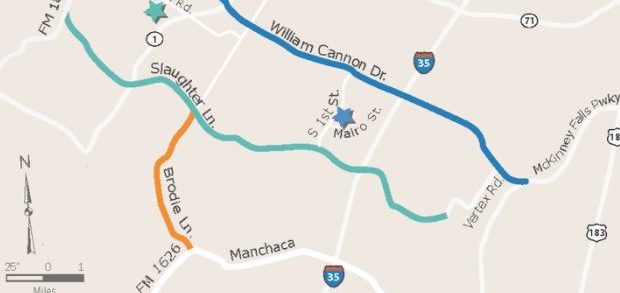Newsletter Signup
The Austin Monitor thanks its sponsors. Become one.
Most Popular Stories
- Parks Board recommends vendor for Zilker Café, while voicing concerns about lack of local presence
- City leaders evaluate surprising ideas for water conservation
- Office slowdown sparks new downtown housing ambitions
- Audit: Economic official granted arts, music funding against city code
- Downtown Historic Resource Survey eyes seven new districts eligible for designation
-
Discover News By District
Popular Whispers
Sorry. No data so far.

Southern corridor plans near finish line
Thursday, November 9, 2017 by Caleb Pritchard
The race to put together a road map of corridor spending from 2016’s mobility bond election is close to wrapping up its southern leg.
After a condensed, accelerated effort that began in June, the city’s Corridor Program Office has made public a batch of draft recommendations to overhaul Slaughter Lane and William Cannon Drive.
Staff debuted the proposals to the public at two open houses last week and will continue to collect feedback through the end of the month.
“Next we will finalize the recommendations, and those will be prioritized alongside recommendations and plans for the seven other corridors that are eligible for construction as part of the corridor construction program,” explained Corridor Program Office spokesperson Sara Behunek.
The seven other eligible corridors include stretches of Burnet Road, North Lamar Boulevard, Airport Boulevard, South Lamar Boulevard, Guadalupe Street, FM 969 and East Riverside Drive. Last year, voters approved $482 million out of a total $720 million bond package to fund projects along those corridors based on studies that had previously been conducted.
Unlike the other corridors, the Slaughter Lane and William Cannon Drive studies focus on the entire lengths of both roads. And while many of the other roads were once rural highways built by the state (and in some cases, such as North Lamar Boulevard, still owned by the state), both of the southern roads were laid down by the city.
Furthermore, each of the previous corridor plans included long-term recommendations focused less on mobility and more on making the corridors more livable destinations, a feature largely absent from the new studies.
“I think these corridors, because they have more of a suburban context, don’t have quite as much placemaking. But that’s not to say that at some point in the future, as the ring of development moves out, that couldn’t change,” Corridor Program Office Director Mike Trimble told the Austin Monitor on Wednesday. “But for right now, what we’re looking at is how do we improve mobility and how do we improve multimodal options, given the context.”
The recommendations generally include new medians, turning lanes, shared-use paths, and bike lanes of both the painted and protected variety. One section of Slaughter Lane between Brodie Lane and MoPac Expressway could see an expansion from two lanes to three lanes each way. Just east of Interstate 35, however, the recommendations call for the reduction from three to two lanes each way, with an eye toward a future re-expansion.
Likewise, one car lane each way on William Cannon Drive between Southwest Parkway and State Highway 71 could be converted to a bike lane. East of Brodie Lane, the road would be enlarged from four to six lanes in both directions.
In addition to the corridor studies, the city is working on a preliminary engineering report for Brodie Lane. That north-south roadway doesn’t qualify as an official corridor but is rather considered a substandard street. The engineering report is being funded by mobility bond money, but work on any of its recommendations will have to be paid for by a future source of funds.
More details about each planning effort can be found here. Staff will present all three to several South Austin stakeholder groups next week. Online feedback will continue to be collected through Nov. 26.
Once the Slaughter Lane and William Cannon Drive plans are finalized, corridor program staff will use them as references during the development of the corridor construction program, which is scheduled for City Council’s consideration by early March.
Map courtesy of the city of Austin.
The Austin Monitor’s work is made possible by donations from the community. Though our reporting covers donors from time to time, we are careful to keep business and editorial efforts separate while maintaining transparency. A complete list of donors is available here, and our code of ethics is explained here.
You're a community leader
And we’re honored you look to us for serious, in-depth news. You know a strong community needs local and dedicated watchdog reporting. We’re here for you and that won’t change. Now will you take the powerful next step and support our nonprofit news organization?


